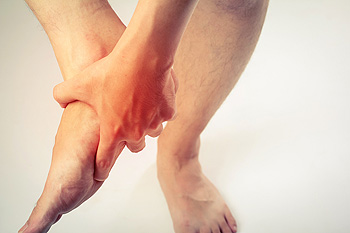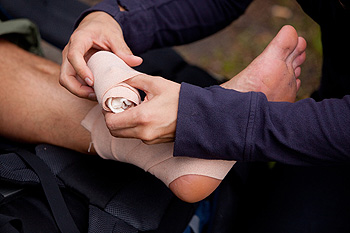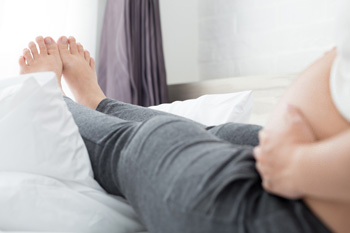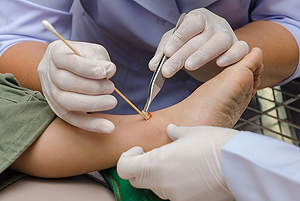Items filtered by date: May 2021
What Happens When You Sprain Your Ankle?
Ligaments are strong, stretchy tissues that connect bones and also stabilize joints. Ligaments on the inside and outside of the ankle joint support the ankle and help stabilize it during up-and-down and side-to-side foot movements. An ankle sprain occurs when one or more of these ligaments become overly stretched or torn from a sudden movement, fall, or twist that knocks the ankle out of its normal position. Ankle sprains can occur while participating in sports, walking on uneven surfaces, or twisting your ankle wearing the wrong shoes. People who have had previous ankle sprains or weakened ankles due to genetics may be more prone to experiencing ankle sprains. Walking may prove challenging to a person with an ankle sprain, and they may experience pain, swelling, bruising, or joint stiffness. It is important to seek the care of a podiatrist for an ankle sprain in order to diagnose and treat any additional, more serious injury that may have occurred, as well as to facilitate proper and prompt healing and rehabilitation to avoid chronic ankle instability.
Although ankle sprains are common, they aren’t always minor injuries. If you need your ankle injury looked at, contact Dr. Mark Gagnon from Advanced Podiatry. Our doctor can provide the care you need to keep you pain-free and on your feet.
How Does an Ankle Sprain Occur?
Ankle sprains are the result of a tear in the ligaments within the ankle. These injuries may happen when you make a rapid shifting movement while your foot is planted. A less common way to sprain your ankle is when your ankle rolls inward while your foot turns outward.
What Are the Symptoms?
- Pain at the sight of the tear
- Bruising/Swelling
- Ankle area is tender to touch
- In severe cases, may hear/feel something tear
- Skin discoloration
Preventing a Sprain
- Wearing appropriate shoes for the occasion
- Stretching before exercises and sports
- Knowing your limits
Treatment of a Sprain
In many cases, the RICE method (Rest, Ice, Compression, and Elevate) is used to treat ankle sprains. However, you should see a podiatrist to see which treatment option would work best with your injury. In severe cases, surgery may be required.
It is important to ask your doctor about rehab options after you receive treatment for your injury. Stretching, strength training, and balance exercises may help the ankle heal while also preventing further injury.
If you have any questions, please feel free to contact one of our offices located in Crestwood, Orland Park, and Summit, IL . We offer the newest diagnostic and treatment technologies for all your foot care needs.
What Causes Cuboid Syndrome?
 Cuboid syndrome is a condition in which the cuboid bone, located in the middle of the foot, becomes misaligned. This usually occurs as the result of an acute injury, such as an ankle sprain, or from repetitive impacts from activities like running or dancing. The cuboid bone moves out of its normal position when the ligaments between the cuboid and other bones in the foot are overstretched or torn. If you have this condition, you may feel pain, discomfort, or weakness along the outer edge of the foot. Placing weight on the affected foot may be painful and make standing and walking difficult. You may also notice mild swelling and bruising on the outside and bottom of the foot. If you are experiencing the symptoms of cuboid syndrome, please see a podiatrist for treatment.
Cuboid syndrome is a condition in which the cuboid bone, located in the middle of the foot, becomes misaligned. This usually occurs as the result of an acute injury, such as an ankle sprain, or from repetitive impacts from activities like running or dancing. The cuboid bone moves out of its normal position when the ligaments between the cuboid and other bones in the foot are overstretched or torn. If you have this condition, you may feel pain, discomfort, or weakness along the outer edge of the foot. Placing weight on the affected foot may be painful and make standing and walking difficult. You may also notice mild swelling and bruising on the outside and bottom of the foot. If you are experiencing the symptoms of cuboid syndrome, please see a podiatrist for treatment.
Cuboid syndrome, also known as cuboid subluxation, occurs when the joints and ligaments near the cuboid bone in the foot become torn. If you have cuboid syndrome, consult with Dr. Mark Gagnon from Advanced Podiatry. Our doctor will assess your condition and provide you with quality foot and ankle treatment.
Cuboid syndrome is a common cause of lateral foot pain, which is pain on the outside of the foot. The condition may happen suddenly due to an ankle sprain, or it may develop slowly overtime from repetitive tension through the bone and surrounding structures.
Causes
The most common causes of cuboid syndrome include:
- Injury – The most common cause of this ailment is an ankle sprain.
- Repetitive Strain – Tension placed through the peroneus longus muscle from repetitive activities such as jumping and running may cause excessive traction on the bone causing it to sublux.
- Altered Foot Biomechanics – Most people suffering from cuboid subluxation have flat feet.
Symptoms
A common symptom of cuboid syndrome is pain along the outside of the foot which can be felt in the ankle and toes. This pain may create walking difficulties and may cause those with the condition to walk with a limp.
Diagnosis
Diagnosis of cuboid syndrome is often difficult, and it is often misdiagnosed. X-rays, MRIs and CT scans often fail to properly show the cuboid subluxation. Although there isn’t a specific test used to diagnose cuboid syndrome, your podiatrist will usually check if pain is felt while pressing firmly on the cuboid bone of your foot.
Treatment
Just as the range of causes varies widely, so do treatments. Some more common treatments are ice therapy, rest, exercise, taping, and orthotics.
If you have any questions, please feel free to contact one of our offices located in Crestwood, Orland Park, and Summit, IL . We offer the newest diagnostic and treatment technologies for all your foot care needs.
Foot Care and Footwear During Pregnancy
Pregnancy causes many changes in your body, including your feet. Swelling in the feet or ankles (edema) may occur, especially at the end of the day or after spending time on your feet. You can help alleviate this discomfort by elevating your feet whenever you get the chance, keeping yourself hydrated, wearing comfortable shoes with low heels, exercising your feet by rotating them and flexing them up and down, and sleeping on your left side to help circulation. While edema will normally subside after pregnancy, an increase in your foot’s size may not. A hormone called relaxin is released during pregnancy to prepare your body for birth, which can also relax the ligaments in your feet, causing them to lengthen and widen. To keep your feet as comfortable as possible during pregnancy, wear flat or low-heeled shoes with good arch support. As you advance in your pregnancy, you may want to avoid laces and opt for slip-on shoes, and always check your foot size before buying new shoes. For more information on how to properly care for and dress your feet during pregnancy, consult with a podiatrist.
Getting the right shoe size is an important part of proper foot health. Seek the assistance of Dr. Mark Gagnon from Advanced Podiatry. Our doctor will provide the care you need to keep you pain-free and on your feet.
Getting the Right Shoe Size
There are many people who wear shoes that are the incorrect size, negatively affecting their feet and posture. Selecting the right shoes is not a difficult process, so long as you keep several things in mind when it comes to choosing the right pair.
- When visiting the shoe store, use the tools available to measure your foot.
- Be sure there is ‘wiggle room’. There should be about an inch between your toes and the tip of your shoes.
- Do not always assume you are the same size, as manufacturers run differently.
- Purchase shoes later in the day, as your feet swell as the day progresses.
- If a shoe is not comfortable, it is not suitable. Most shoes can’t be ‘broken in’, and comfort should be the ultimate goal when it comes to choosing the right pair of shoes
As our feet hold our body weight and keep us moving, it is important to treat them right. Picking the right pair of shoes can provide your feet comfort and mobility without pain.
If you have any questions, please feel free to contact one of our offices located in Crestwood, Orland Park, and Summit, IL . We offer the newest diagnostic and treatment technologies for all your foot care needs.
What Should I Do If I See a Wound on My Foot?
Foot wounds are sores, cuts, or scrapes that can appear on the feet. If you have systemic conditions such as diabetes, peripheral neuropathy, or poor circulation, these wounds may heal slowly and poorly, resulting in potentially serious complications, from infection to amputation. If you notice a wound on your foot, you should protect the wound from bacteria immediately. Wash the wound thoroughly with clean water, then apply an antibiotic ointment. Cover the wound with a bandage, as leaving the wound open to air might allow bacteria to multiply on and infect the wound. Change the bandage and repeat this process every one to two days. Keep pressure off the wound by resting the affected foot. Your doctor may also suggest wearing specialized shoes or socks to offload pressure. If you have a foot wound, it is suggested that you seek the care of a podiatrist as soon as possible.
Wound care is an important part in dealing with diabetes. If you have diabetes and a foot wound or would like more information about wound care for diabetics, consult with Dr. Mark Gagnon from Advanced Podiatry. Our doctor will assess your condition and provide you with quality foot and ankle treatment.
What Is Wound Care?
Wound care is the practice of taking proper care of a wound. This can range from the smallest to the largest of wounds. While everyone can benefit from proper wound care, it is much more important for diabetics. Diabetics often suffer from poor blood circulation which causes wounds to heal much slower than they would in a non-diabetic.
What Is the Importance of Wound Care?
While it may not seem apparent with small ulcers on the foot, for diabetics, any size ulcer can become infected. Diabetics often also suffer from neuropathy, or nerve loss. This means they might not even feel when they have an ulcer on their foot. If the wound becomes severely infected, amputation may be necessary. Therefore, it is of the upmost importance to properly care for any and all foot wounds.
How to Care for Wounds
The best way to care for foot wounds is to prevent them. For diabetics, this means daily inspections of the feet for any signs of abnormalities or ulcers. It is also recommended to see a podiatrist several times a year for a foot inspection. If you do have an ulcer, run the wound under water to clear dirt from the wound; then apply antibiotic ointment to the wound and cover with a bandage. Bandages should be changed daily and keeping pressure off the wound is smart. It is advised to see a podiatrist, who can keep an eye on it.
If you have any questions, please feel free to contact one of our offices located in Crestwood, Orland Park, and Summit, IL . We offer the newest diagnostic and treatment technologies for all your foot care needs.




